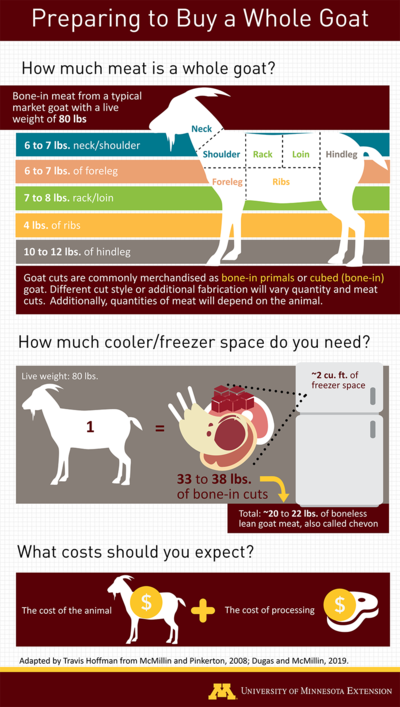Having a variety of meat cuts on hand whenever you want them is a great convenience. And buying meat in bulk can help you save money over time if you and your family regularly eat meat.
Many people will go in on a larger quantity of meat with family and friends to lower and spread the cost. Buying a whole animal and dividing it by two or more people is an economical way to go. But remember, there are only so many steaks, chops and roasts to go around. So make sure you know what you're getting.
There are several things to think about before you commit to buying a quarter, half, or whole animal for your freezer.
Finding a local farmer or processor
You can work directly with a local butcher and, often, with a local farmer to find an animal ready for processing.
Minnesota Grown lists local farms that sell whole and partial animals to consumers. Use their keyword search with terms such as "whole beef" or "whole lamb" to find sources near you. Many of these producers can be found at local farmers markets.
Your butcher will let you know how many cuts to expect from the live weight of the animal. The Minnesota Department of Agriculture lists custom exempt plants that may process meat and poultry for the owner of the animal.
Commercial and wholesale producers may find helpful the MDA's Minnesota State "equal to" plants and resources for meat, poultry and egg inspections.
The following charts can help you make sense of the bulk meat buying process.
Buying a quarter of beef
A typical quarter of beef from a cow with a live weight of 1300 pounds should provide you with about 142 pounds of meat.
Typical cuts from 1/4 cow
- 7 ribeye steaks
- 6 T-bone steaks
- 3 sirloin steaks
- 3 sirloin tip steaks
- 3 round steaks
- 6 roasts
- 35 to 60 pounds of ground beef
Freezer space
You'll need at least 4.5 cubic feet of space in a chest freezer or 5.5 cubic feet of space in an upright freezer for 142 pounds of beef.
Cost
For a quarter of beef, the cost of the whole animal is divided by 4. Each buyer is responsible for their share of the cost of processing.
Buying half a hog
A typical half a hog with a live weight of 250 to 270 pounds should give you 60 to 70 pounds of pork.
Typical cuts from 1/2 hog
- 12 to 14 pounds of pork chops
- 3 4-pound shoulder roasts
- 3 pounds of spare ribs
- 8-10 pounds of bacon
- 15-18 pounds of ham
- 2 hocks
- 6 to 10 pounds of ground pork or sausage
- Additional products: heart, liver, tongue, fat and lard
Freezer space
50 pounds of pork can fit in an empty, average-size home freezer with 2.25 cubic feet of space.
Cost
The cost of the whole animal is divided by 2. Each buyer is responsible for their share of the cost of processing.
Buying a whole lamb
A typical market lamb with a live weight of 140 pounds should give you 47 pounds of meat.
Typical cuts from a whole lamb
- 8 8-ounce shoulder chops
- 16 4-ounce rib chops or 2 2-pound crown roasts
- 14 6-ounce loin chops
- 4 1-pound shanks
- 2 2-pound sides of ribs
- 10 to 12 pounds of ground lamb
- 15 pounds of boneless leg for kebabs, stew meat, roast or ground lamb
Freezer space
47 pounds of lamb needs 2.25 cubic feet of space in an average-size home freezer.
Cost
The cost of the whole animal plus the cost of processing.
Buying a whole goat
A typical market lamb with a live weight of 80 pounds should give you 33 to 38 pounds of meat.
Typical cuts from a whole goat
- 6 to 7 pounds neck and shoulder
- 6 to 7 pounds foreleg
- 7 to 8 pounds rack and loin
- 4 pounds of ribs
- 10 to 12 pounds hindleg
Freezer space
33 to 38 pounds of bone-in meat or 20 to 22 pounds of boneless meat needs 2 cubic feet of space in an average-size home freezer.
Cost
The cost of the whole animal plus the cost of processing.
Buying whole chickens
A typical broiler chicken with a live weight of 6 pounds should give you 4.5 to 5 pounds of meat.
Typical cuts from a whole chicken
- Neck; roast or use for stock
- 2 wings; white meat
- 2 breasts; white meat
- 2 thighs; dark meat
- 2 legs; dark meat
- 2 feet; roast or use for stock
- Giblets: heart, gizzard and liver often included with whole birds
Freezer space
- 2 whole chickens averaging 4.5 to 5 pounds of meat per carcass need 1 cubic foot of space in an average-size home freezer.
- 30 whole chickens at the same above weight can fill about 15 cubic feet of freezer space.
Cost
The cost of the whole chicken plus the cost of processing. Processing costs may be included in the price of birds sold custom or retail.
Chart designs: Hannah Lochner, CFANS graduate student
Beef and Pork Whole Animal Meat Buying Guide, Iowa State University
Sheep chart information by Travis Hoffman, Extension sheep specialist
Goat chart information adapted by Travis Hoffman from materials by McMillin and Pinkerton (2008), and Dugas and McMillin (2019).
Reviewed in 2020






